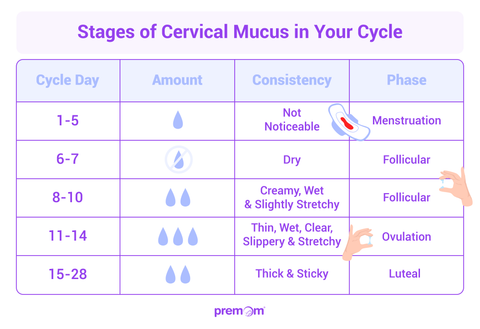The two week wait can quite honestly be the longest two weeks ever while you’re trying to conceive. As you’re waiting to discover if you were successful in your endeavors, you’re taking note of every twinge and peeing on pregnancy tests at 8 DPO knowing they’re likely negative at this point. Waiting is so hard, but did you know your cervical mucus can actually be a telltale sign of early pregnancy?
Stages of cervical mucus during your cycle
Cervical mucus is a great indicator of fertility and your health. It ebbs and flows throughout your menstrual cycle due to fluctuations in the hormones estrogen and progesterone.
Let’s walk through an average 28-day cycle without conception for example:
- Cycle day 1-5: During your period – you still produce cervical mucus, it’s just not quite as noticeable due to the blood.
- Cycle day 6-7: After your period ends – you may experience a couple of dry days or a variety of discharges.
- Cycle day 8-10: Before ovulation – mucus may be creamy, wet, slightly stretchy or a combination as you near the start of your fertile window.
- Cycle day 11-14: Near ovulation time – cervical mucus will start to become thin, wet, clear, slippery, and stretchy until reaching peak fertility discharge that resembles raw egg whites.
- Cycle day 15-28: Cervical mucus after ovulation – may be thick, sticky discharge off and on until the menstrual cycle starts again due to the hormone progesterone that works to keep sperm out of the cervix.
It’s important to keep in mind that not every woman has a 28-day cycle and ovulation will not necessarily occur on cycle day 14. Monitoring changes in cervical mucus in addition to tracking luteinizing hormone (LH) levels can increase chances of pregnancy when intercourse is timed during the fertile window.

What does cervical mucus look like in early pregnancy?
If conception occurred, you’re less likely to experience any dryness after ovulation, but rather a range of discharge consistencies.
A woman’s body is so incredibly smart! Pregnancy hormones tell your body to protect that precious fertilized egg and you may see the result of that through vaginal discharge. Now when you see that glob of discharge in your undies, know it is a good sign of health!
When implantation occurs, it’s also common to experience some light spotting mixed with cervical mucus. This is due to the embryo nestling its way into the uterine lining and making a nice, cozy home for the next 9 months.
Is no discharge when pregnant normal?
Some women experience little to no cervical mucus in early pregnancy while others find themselves reaching for pantyliners to save themselves from changing another pair of discharge-soaked undies.
Every woman is unique, so it’s beneficial to track your particular discharge patterns throughout your cycle. You can easily log your cervical mucus amount and consistency within the Premom app to detect any changes that could clue you in that you’re pregnant before you experience any other symptoms.
Other signs of early pregnancy
Due to its subtlety, some women do not notice a significant change in vaginal discharge in early pregnancy. These are the most common early symptoms and signs of pregnancy:
- Missed period
- Cramping
- Light spotting called implantation bleeding between 6-10 days post ovulation
- Frequent urination
- Breast tenderness
- Bloating
- Fatigue
- Nausea
- Heightened sense of smell
- Moodiness
Abnormal discharge? When to call your doctor.
As long as your vaginal discharge is normal in color, consistency, and without odor, then consider it a sign of health! Cervical mucus production is stimulated due to all of the wonderful hormones that are surging in early pregnancy so it’s perfectly normal to experience cervical mucus that is clear, wet, creamy or tacky.
But if any of the following describe your discharge, it’s a good idea to reach out to your doctor:
- Green, yellow, or gray in color
- A cheesy or lumpy consistency
- Has a foul odor
- Accompanied by swelling, itchiness, or redness around your vagina
- Accompanied by pain when urinating
These symptoms could indicate a possible infection. Don’t ever feel intimidated or embarrassed to reach out to your doctor for something like this – they see it all the time! Both you and your doctor will be glad you called.
References
- Kumar P, Magon N. Hormones in pregnancy. Niger Med J. 2012. 53:179-83. Available from: https://www.nigeriamedj.com/text.asp?2012/53/4/179/107549
- Sim, M., Logan, S., & Hoon Goh, L. (2020). Vaginal discharge: evaluation and management in primary care. Singapore Med J, 61(6), 297–301. https://doi.org/10.11622/smedj.2020088
- Evans-Hoeker, E., Pritchard, D., Long, L., Herring, Amy, Stanford, J., & Steiner, A. (2013). Cervical mucus monitoring prevalence and associated fecundability in women trying to conceive, Fertility and Sterility, 100(4), 1033-1038.e1, ISSN 0015-0282, https://doi.org/10.1016/j.fertnstert.2013.06.002.



